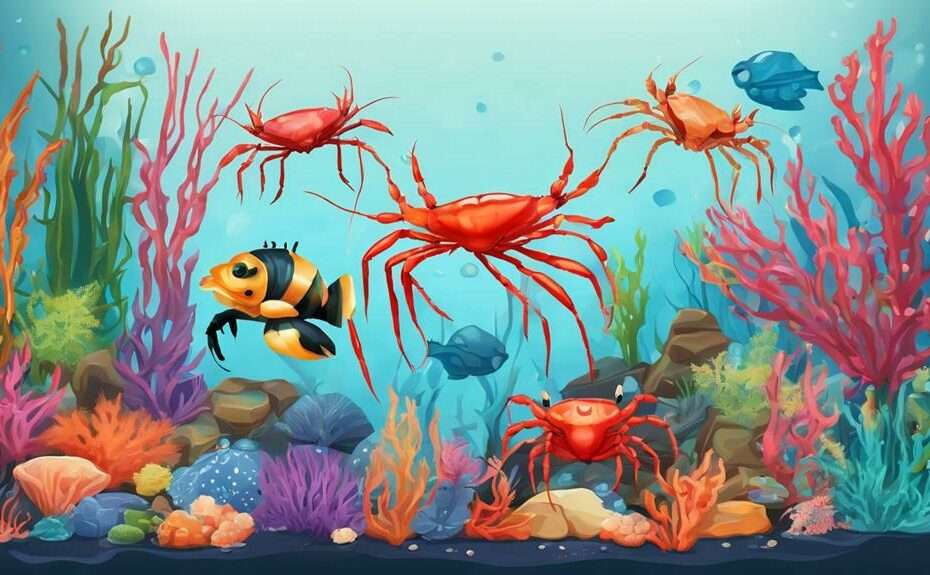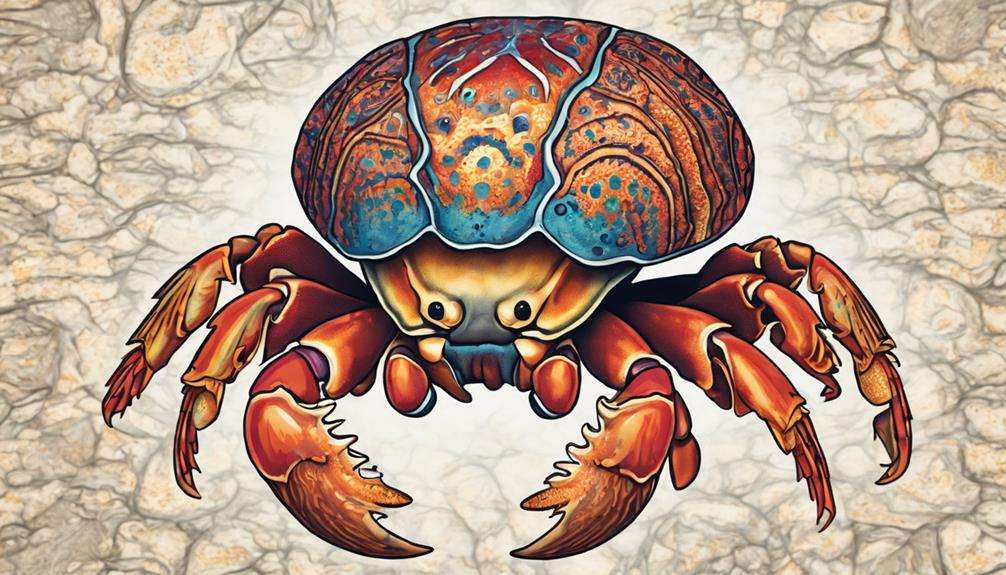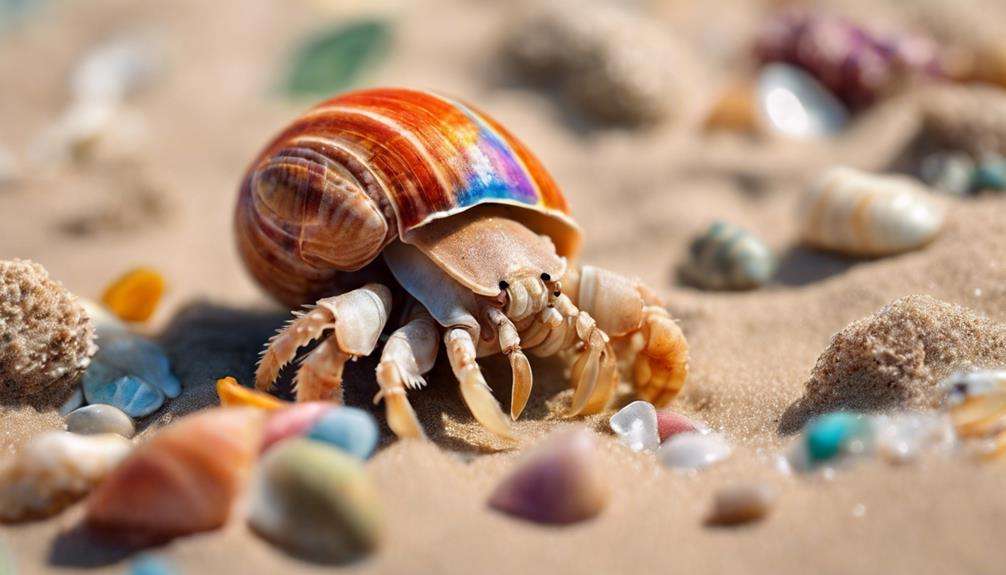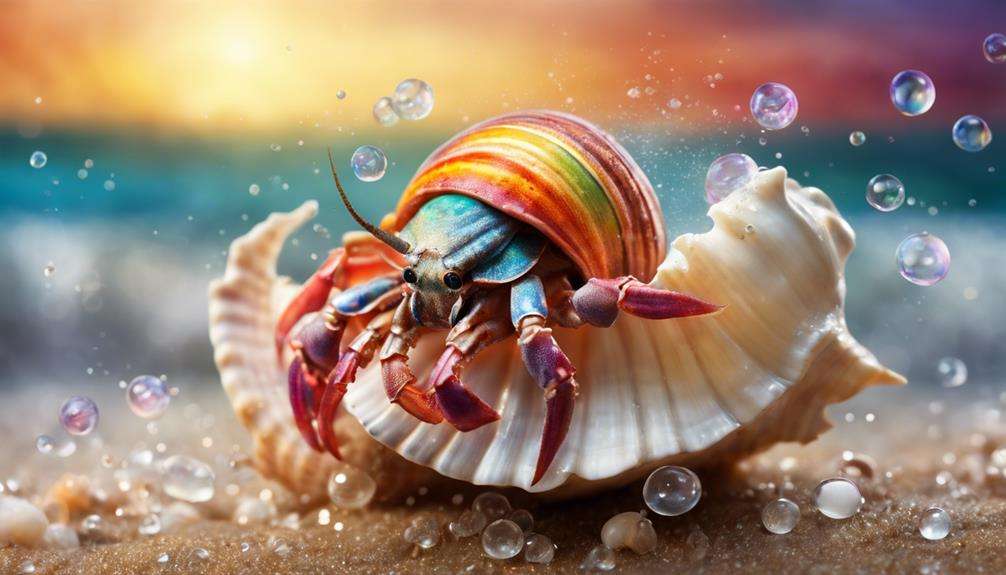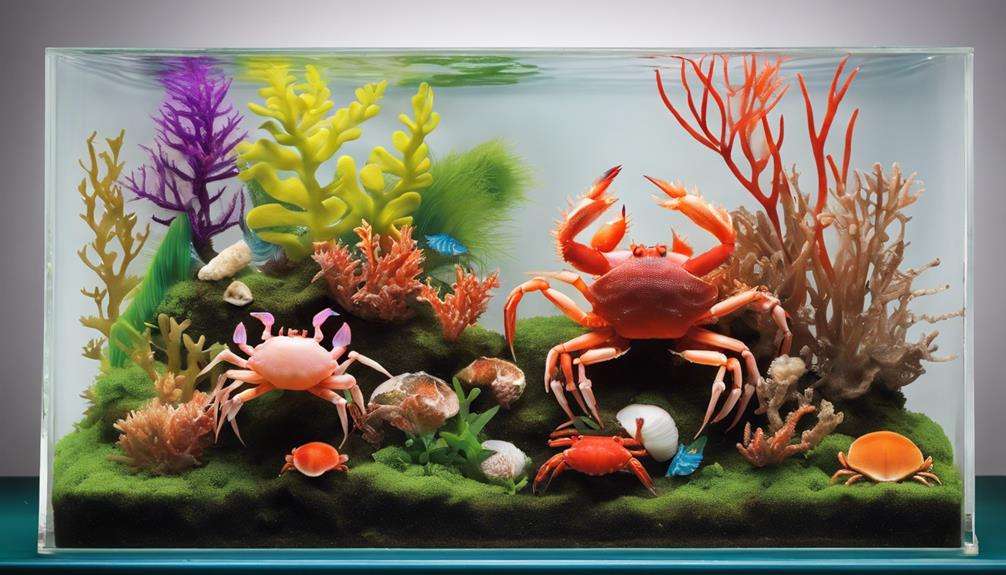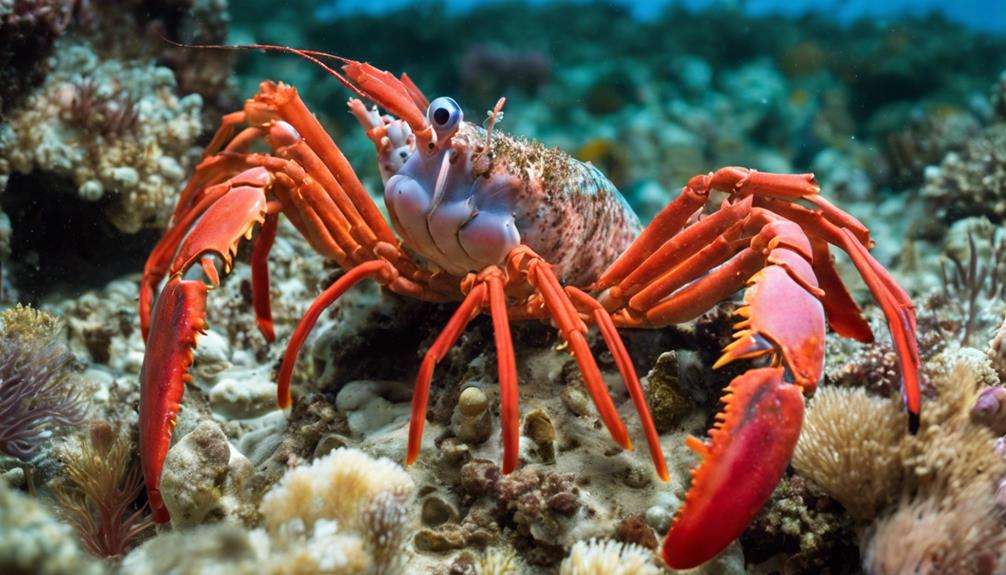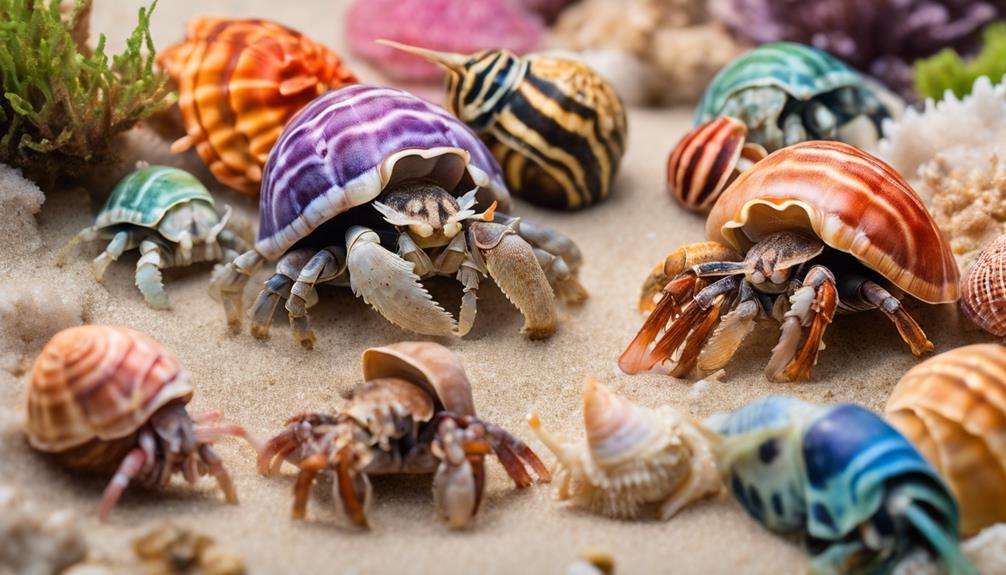Imagine your aquascape as a blank canvas waiting to be adorned with the intricate beauty of exotic crustaceans. Picture the elegance of a Rainbow Lobster gracefully moving through your underwater garden, adding a burst of color and charm.
Each unique crustacean brings its own flair, but which one will truly captivate you and become the centerpiece of your aquatic masterpiece? Consider the endless possibilities these creatures offer and how they can transform your aquascape into a mesmerizing work of art.
Key Takeaways
- Rainbow Lobster and Vampire Crab offer vibrant colors and unique patterns for visually stunning aquascapes.
- Crustaceans like Peacock Mantis Shrimp add depth with territorial behaviors and striking appearance.
- Blue Leg Hermit Crabs and Red Claw Crabs are perfect for community tanks, showcasing interesting behaviors.
- Algae control can be achieved with Thai Micro Crabs, Emerald Crabs, and Amano Shrimp, maintaining tank cleanliness.
Rainbow Lobster: A Colorful Addition
Rainbow Lobsters, with their rare and captivating split coloring, are a highly sought-after addition for aquascaping enthusiasts seeking a vibrant and unique crustacean specimen. These freshwater crustaceans belong to the Cherax genus and are native to rivers and streams in Indonesia. Their mesmerizing appearance, with one half of their body displaying dark brown hues while the other side shines in brilliant shades of blue, orange, or red, makes them a prized gem in the aquarium trade.
In the wild, Rainbow Lobsters thrive in freshwater environments with stable water parameters and plenty of hiding spots among rocks and vegetation. When introduced to aquascapes, they bring a pop of color and a touch of whimsy to the tank. Their adaptability to various water conditions and omnivorous diet make them relatively easy to care for, making them an ideal choice for both beginner and experienced aquarists looking to add a splash of color to their setups.
Vampire Crab: Mysterious and Intriguing
You may find the Vampire Crab to be a fascinating addition to your aquascape due to its unique appearance and intriguing behavior.
These crabs, with their dark bodies, vibrant legs, and intricate carapace patterns, can add a mysterious touch to your aquatic setup.
Their omnivorous diet and semi-aquatic requirements make them a versatile choice for aquarists looking to create a captivating and dynamic environment.
Unique Vampire Crab
Vampire crabs, scientifically identified as Geosesarma hagen, captivate aquarists with their vibrant colors and unique patterns. These mysterious crustaceans showcase a stunning array of hues, ranging from purple, blue, and black to orange and red, making them a striking addition to any aquascape.
When setting up a terrarium for vampire crabs, it's essential to provide a combination of land and water areas to accommodate their semi-terrestrial nature. This setup allows them to exhibit their intriguing behaviors such as climbing and digging, adding an extra layer of fascination for enthusiasts.
With their captivating appearance and fascinating habits, it's no wonder that vampire crabs are highly sought after in the world of aquarists.
Aquascaping Potential
Captivating aquascapers with their mysterious allure and intriguing behaviors, Geosesarma hagen, commonly known as vampire crabs, offer a unique aquascaping potential that adds depth and fascination to aquatic environments.
When considering their aquascaping potential, here are some key aspects to keep in mind:
- Landscaping techniques: Creating a habitat that includes both land and water areas is crucial for vampire crabs to thrive.
- Aesthetic appeal: Their striking red eyes and unique color variations make them visually appealing additions to any aquascape.
- Social dynamics: Vampire crabs exhibit interesting social behaviors, making them engaging to observe within a well-designed setup.
- Habitat requirements: Ensuring the right aquatic balance is essential for the overall health and wellbeing of these captivating crustaceans.
Thai Micro Crab: Tiny Yet Impactful
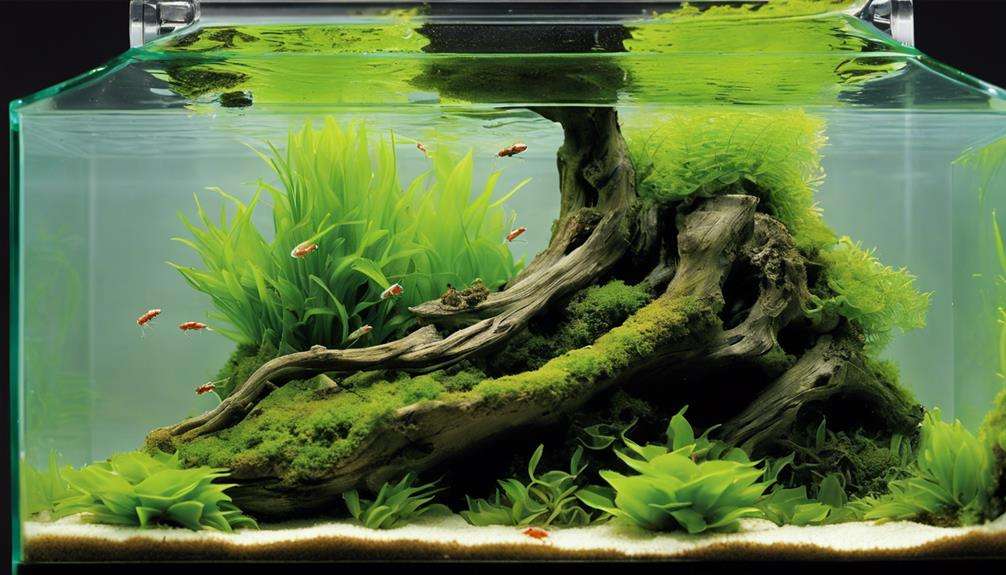
Thai Micro Crabs, scientifically known as Limnopilos naiyanetri, are diminutive creatures that hold significant allure in aquascaping due to their petite size and intriguing behavior.
These tiny crustaceans, typically measuring around 1 centimeter, exhibit peaceful tendencies, making them suitable for communal setups in tanks as small as 5 gallons.
Their preference for scavenging on algae, detritus, and leftover food contributes to the overall balance of a well-established aquarium ecosystem.
Size and Behavior
In the realm of aquascaping, the diminutive yet impactful Thai Micro Crab stands out for its remarkable size and behavior in the underwater habitat. These small wonders, with a carapace size of about 1 centimeter, exhibit fascinating climbing antics on plants and decorations within the aquarium. Their peaceful coexistence with other small aquatic creatures like shrimp and snails makes them ideal tank mates. Thai Micro Crabs, with their scavenging nature, play a vital role in maintaining tank cleanliness by consuming excess food and debris. Due to their tiny size and interesting behavior, these crabs are favored choices for nano aquascapes and shrimp tanks.
- Thai Micro Crabs have a carapace size of approximately 1 centimeter.
- They exhibit unique climbing antics on plants and decorations.
- These crabs peacefully coexist with other small aquatic creatures like shrimp and snails.
- Thai Micro Crabs help clean up excess food and debris in the tank.
Tank Compatibility
With their diminutive size and peaceful demeanor, Thai micro crabs are compatible inhabitants for nano tanks and well-maintained aquatic environments.
When considering tank mates for these tiny crustaceans, opt for small, non-aggressive fish and other peaceful invertebrates to ensure a harmonious cohabitation.
Thai micro crabs are scavengers and omnivores, happily consuming algae, detritus, and leftover fish food.
Maintaining proper water parameters is crucial for their well-being; aim for a pH range of 6.5-8.0, a temperature between 72-82°F (22-28°C), and moderately hard water.
These crabs thrive in environments with ample hiding spots and vegetation, mimicking their natural habitat.
Peacock Mantis Shrimp: A Bold Statement
The Peacock Mantis Shrimp, scientifically known as Odontodactylus scyllarus, stands out as a captivatingly colorful and intriguing crustacean highly sought after in the aquascaping world. Here are some key points to consider when admiring these fascinating creatures:
- Aggressive Behavior and Colorful Appearance: The Peacock Mantis Shrimp's vibrant shades of green, blue, and red not only add a pop of color to your aquarium but also signify its bold and sometimes aggressive nature.
- Territorial Instincts and Hunting Techniques: These mantis shrimp exhibit territorial behavior, requiring careful consideration when choosing tank mates. Their hunting techniques are awe-inspiring, with the ability to deliver a powerful punch to catch prey.
- Tank Setup and Eye Structure: Creating the ideal environment for a Peacock Mantis Shrimp involves providing hiding spots and suitable substrate. Their unique eyesight, capable of perceiving a wide range of colors and detecting polarized light, adds to their allure.
Peacock Mantis Shrimp truly make a bold statement in any aquascape, but their care requirements and behavior should be carefully managed for a harmonious tank environment.
Blue Leg Hermit Crab: Quirky Cleanup Crew
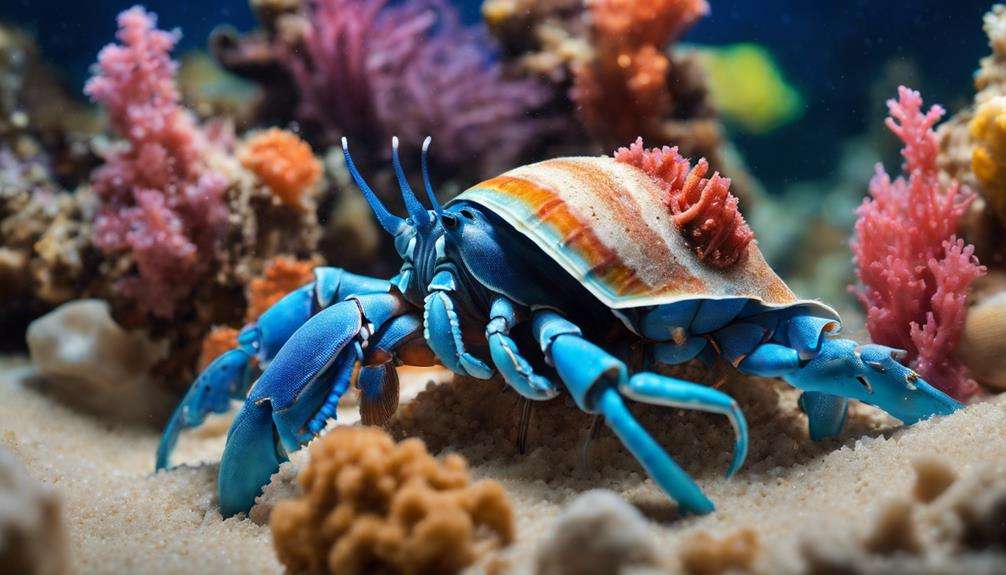
Peacock Mantis Shrimp, known for their striking appearance and bold behavior, share the aquatic spotlight with the Blue Leg Hermit Crab, a quirky member of the cleanup crew in marine aquariums. Blue Leg Hermit Crabs, scientifically known as Calcinus elegans, stand out with their reddish-brown bodies complemented by vibrant blue legs. These crustaceans play a crucial role in maintaining the cleanliness of the aquarium by scavenging algae and debris. When it comes to shell selection, Blue Leg Hermit Crabs are fastidious; they actively seek out suitable shells to inhabit and protect their soft abdomens.
In terms of tankmates, these hermit crabs are peaceful and can coexist harmoniously with various other species, making them an excellent choice for community tanks. Their molting process is fascinating to observe, as they shed their exoskeleton to accommodate growth. Blue Leg Hermit Crabs are omnivores, feeding on algae, detritus, and leftover fish food. Additionally, they're hardy creatures, making them ideal for aquarists of all levels. While their breeding habits aren't commonly observed in captivity, their quirky behavior and efficient cleaning capabilities make them a delightful addition to any marine aquarium setup.
Red Claw Crab: A Vibrant Choice
Amidst the vibrant array of aquatic creatures available for aquascaping enthusiasts, the Red Claw Crab stands out as a striking and captivating choice. These colorful crustaceans, scientifically known as Perisesarma bidens, are prized for their vibrant red claws that add a brilliant contrast to any aquarium setting. If you're considering adding Red Claw Crabs to your aquascape, here are some key points to keep in mind:
- Vibrant Appearance: The most distinctive feature of Red Claw Crabs is their striking red claws, which make them visually appealing inhabitants for your tank.
- Territorial Behavior: Red Claw Crabs exhibit territorial behavior, so providing them with ample hiding spots and space is crucial to prevent aggression among individuals.
- Aquatic Requirements: These crabs are semi-aquatic and require access to both water and a land area in the aquarium to exhibit their natural behaviors effectively.
- Dietary Needs: Red Claw Crabs are omnivores and will feed on algae, plants, insects, and even small fish, so ensure a varied diet to keep them healthy and happy in their environment.
Frequently Asked Questions
What Is the Most Exotic Aquarium Fish?
When it comes to the most exotic aquarium fish, colorful bettas, rare cichlids, and unique guppies top the list. Each species boasts vibrant hues, distinct features, and fascinating behaviors that make them coveted additions to any aquatic setup.
What Are the Small Shrimp Like Creatures in Aquarium?
In freshwater invertebrates, shrimp like Singapore, cherry, Amano, ghost, and crystal red shrimp are common. They play vital roles in shrimp tank setups, aiding in algae control and maintaining tank balance. Nano aquascaping trends often feature these small crustaceans.
What Are the Best Fish for Aquascape Tanks?
For your aquascape tank, the best fish choices depend on plant selection and tank size. Consider Rasbora fish for their vibrant colors, Neon tetras for liveliness, Corydoras catfish for bottom cleaning, and Siamese algae eaters for algae control.
What Are Fully Aquatic Crabs for Aquarium?
For your aquarium, consider fully aquatic crabs. These creatures exhibit fascinating behaviors, vibrant colors, and unique freshwater adaptations. Their presence adds depth and intrigue to your tank, making them a captivating addition to your aquatic ecosystem.
Conclusion
As you delve into the fascinating world of exotic crustaceans for aquascaping, remember that the intricate beauty of these creatures can elevate your underwater landscape to new heights.
From the vibrant colors of the Rainbow Lobster to the mysterious allure of the Vampire Crab, each species brings its own unique charm.
Embrace the bold statements of the Peacock Mantis Shrimp and the quirky cleanup crew of the Blue Leg Hermit Crab.
With a vibrant choice like the Red Claw Crab, your aquascape will truly stand out in a sea of ordinary.
